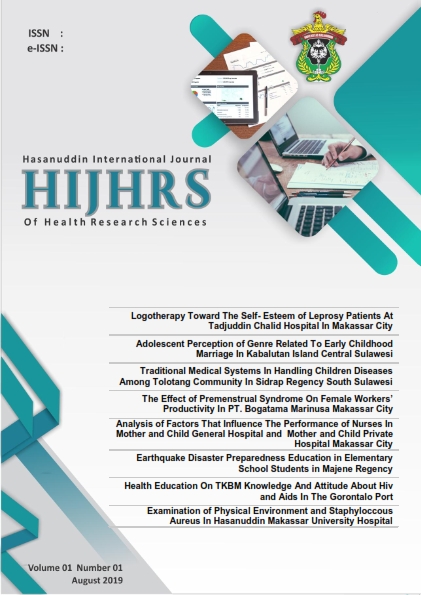ANALYSIS OF THE EXISTENCE OF BACTERIA AND BATHERS BEHAVIOR AT TANJUNG BAYANG BEACH MAKASSAR CITY
Abstrak
Contamination of sea water by pollutants is a public health problem in various parts of the world, and bathing in polluted water usually creates the danger of contracting an infection. Humans can be exposed to various microorganisms that cause disease in recreational waters. This study aims to analyze the presence of bacteria and visitor behavior at the Tanjung Bayang Beach in Makassar City. This study aims to determine the presence of bacteria in seawater with visitor activity in Tanjung Bayang Beach, Makassar City. This study uses an observational analytic method with a descriptive approach. The sample object in the study consisted of 5 sample points with 3 repetitions. The method of sampling the subjects in this study was done by Stratified Random Sampling. The results showed that the other activity most visitors performed was playing sand with a number of 78 respondents (37.1%), the overall sea water samples of Tanjung Bayang beach in Makassar City were taken containing bacteria at five sampling points for three consecutive weeks, swimming activities experiencing health problems, which amounted to 102 respondents (48.6%), the most health problems were itching by 43 respondents (20.5%), swimming visits to Tanjung Bayang beach visitors with the most number was once a month, amounting to 60 respondents ( 28.6%) and the frequency of Swimming Visits on the Visitors of Tanjung Kota Makassar Beach which shows that the length of time swimming visitors at the Tanjung Bayang Beach Makassar City with the most number is 1-2 hours, amounting to 92 respondents (43.8%)Unduhan
Referensi
Ahmed W., Hamilton K.A., Lobos A., Hughes B., Staley C., Sadowsky M.J. & Harwood V.J. (2018). Quantitative microbial risk assessment of microbial source tracking markers in recreational water contaminated with fresh untreated and secondary treated sewage. Environment international, 117:243-249.
Arnold B.F., Wade T.J., Benjamin-Chung J., Schiff K.C., Griffith J.F., Dufour A.P., Weisberg S.B. & Colford Jr J.M. (2016). Acute gastroenteritis and recreational water: highest burden among young US children. American journal of public health, 106(9):1690-1697
Dakka H.A., Aljaroucha A.E.K., Allam N.G. & Shaltout K.H. (2018). Epidemiological and etiological agents of water borne infections among the bathers in the Mediterranean Sea water in Gaza Strip. The Egyptian Journal Of Experimental Biology (Botany), 14(2):299-306.
DeFlorio-Barker S., Arnold B.F., Sams E.A., Dufour A.P., Colford Jr J.M., Weisberg S.B., Schiff K.C. & Wade T.J. (2018). Child environmental exposures to water and sand at the beach: Findings from studies of over 68,000 subjects at 12 beaches. Journal of Exposure Science and Environmental Epidemiology, 28(2):93-100.
Derraik J.G. (2002). The pollution of the marine environment by plastic debris: a review. Marine pollution bulletin, 44(9):842-852.
Dilnessa T. & Demeke G. (2016). Microbiological, Physical and Chemical Quality of Swimming Water with Emphasize Bacteriological Quality. Global Journal of Medical Research, 16(2):18-27.
Dorevitch S., Panthi S., Huang Y., Li H., Michalek A.M., Pratap P., Wroblewski M., Liu L., Scheff P.A. & Li A. (2011). Water ingestion during water recreation. Water research, 45(5):2020-2028.
Dufour A.P., Behymer T.D., Cantu R., Magnuson M. & Wymer L.J. (2017). Ingestion of swimming pool water by recreational swimmers. Journal of water and health, 15(3):429-437.
Ekowati Y. (2019). Protection of public health from microbial and chemical hazards in swimming pool environments. CRC Press.
Elliott L.R., White M.P., Grellier J., Rees S.E., Waters R.D. & Fleming L.E. (2018). Recreational visits to marine and coastal environments in England: Where, what, who, why, and when?. Marine Policy, 97:305-314.
Elmir S.M., Wright M E., Abdelzaher A., Solo-Gabriele H.M., Fleming L.E., Miller, G., Rybolowik M., Shih M.P., Pillai S.P., Cooper J.A. & Quaye E.A. (2007). Quantitative evaluation of bacteria released by bathers in a marine water. Water research, 41(1):3-10.
Houston J.R. (2008). The economic value of beaches: a 2008 update. Shore and beach, 76:22-26.
Jang C.S. & Liang C.P. (2017). Characterizing health risks associated with recreational swimming at Taiwanese beaches by using quantitative microbial risk assessment. Water Science and Technology, 77(2):534-547.
Massinai A., Tahir A. & Abu N. (2019). High concentrations of pathogenic Salmonella spp. during the wet season on bathing beaches in Makassar City, Indonesia. IOP Conference Series: Earth and Environmental Science, 253(1):1-9.
Pascoe S. (2019). Recreational beach use values with multiple activities. Ecological Economics, 160:137-144.
Saraswadewi P.A.A., Ristiati N.P. & Mulyadiharja S. (2016). Analisis Total Koloni Bakteri Yang Terdapat Di Pemandian Air Panas Toya Bungkah Kabupaten Bangli. Jurnal Pendidikan Biologi undiksha, 3(2).
Scheyvens R. (2000). Promoting Women's Empowerment Through Involvement in Ecotourism: Experiences from the Third World. Journal of Sustainable Tourism, 8(3):232 – 249.
Soller J.A., Schoen M.E., Bartrand T., Ravenscroft J.E. & Ashbolt N.J. (2010). Estimated human health risks from exposure to recreational waters impacted by human and non-human sources of faecal contamination. Water Research, 44(16):4674-4691.
UNWTO. (2019). Global Report on City Tourism. Madrin, Spain: United World Tourism Organization.
##submission.downloads##
Diterbitkan
Terbitan
Bagian
Lisensi



